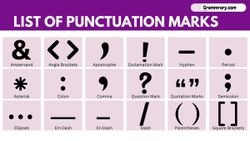Mar 9, 2025
Common Punctuation Marks and Their Names
. → Period (or Full Stop in British English)
, → Comma
: → Colon
; → Semicolon
***** → Asterisk
" " → Quotation Marks (or Inverted Commas in British English)
! → Exclamation Mark (or Exclamation Point in American English)
? → Question Mark
_ → Underscore
- → Hyphen (used to join words, e.g., well-known)
/ → Slash (or Forward Slash)
# → Hash (British English) / Pound Sign (American English) / Number Sign
@ → At Symbol (commonly called "At")
' → Apostrophe (used for contractions or possession, e.g., don't, John's)
() → Parentheses (or Brackets in British English)
1. Comma (,)
Used to separate ideas, list items, and clauses.
To separate items in a list:
I like pizza, pasta, and salad.
To separate clauses (when using conjunctions like and, but, or, because):
I went to the park, but it started raining.
After introductory phrases:
After lunch, we went shopping.
With non-essential information (like relative clauses):
My friend, who loves reading, is always at the library.
2. Period (.)
Used to end a sentence or statement.
To end a declarative sentence:
I am going to the store.
To end short, complete thoughts:
She likes coffee.
3. Question Mark (?)
Used to end a direct question.
To ask a question:
What time is the meeting?
Where did you go yesterday?
4. Exclamation Mark (!)
Used to show strong feeling or emphasis.
To show excitement or surprise:
Wow, that's amazing!
I can’t believe it!
After commands or strong reactions:
Stop that right now!
Help!
5. Quotation Marks (" ")
Used to show direct speech, quotes, or titles of short works.
To quote someone:
She said, "Let's go to the beach."
To show a title of a short work (like a song or article):
I love the song "Imagine" by John Lennon.
6. Apostrophe (')
Used for possession and contractions.
For possession:
That is Sarah’s book.
The dog’s toy is missing.
In contractions (to show missing letters):
I can’t wait for the weekend.
It’s raining outside.
7. Colon (:)
Used to introduce lists, explanations, or quotes.
To introduce a list:
I need the following items: bread, butter, eggs, and cheese.
To introduce an explanation or elaboration:
She has one goal in life: to become a doctor.
Before a quote:
He said: "I’ll meet you at the park."
8. Semicolon (;)
Used to link related independent clauses or separate items in a complex list.
To link closely related independent clauses:
I wanted to go to the beach; however, it started raining.
To separate items in a complex list:
The meeting included attendees from Paris, France; London, England; and Madrid, Spain.
9. Parentheses (())
Used to add extra information or clarification.
For extra information:
I finally saw the movie (after waiting for months).
John (my best friend) is visiting next week.
10. Dash (—)
Used to add emphasis or interrupt a thought.
For emphasis or extra information:
I can’t believe it — she actually won the prize!
For dramatic pauses or interruption:
She was going to tell me everything — then she stopped.
11. Hyphen (-)
Used to join words or parts of words.
To form compound words:
This is a well-known book.
I need a two-story house.
12. Ellipsis (...)
Used to show omission, unfinished thoughts, or a pause.
To show missing words or a pause:
She said she would come, but...
To show unfinished thoughts or hesitation:
I’m not sure what to do... I guess I’ll decide later.

Quick Summary:
Commas: Separate ideas, lists, and clauses.
Periods: End statements.
Question Marks: End direct questions.
Exclamation Marks: Show strong emotion or emphasis.
Quotation Marks: Direct speech, quotes, or short works.
Apostrophes: Possession or contractions.
Colons: Introduce lists, explanations, or quotes.
Semicolons: Link related clauses or separate complex items.
Parentheses: Add extra information.
Dashes: Emphasize or interrupt.
Hyphens: Join words or parts of words.
Ellipses: Omission or unfinished thoughts.
By undefined
4 notes ・ 2 views
English
Elementary